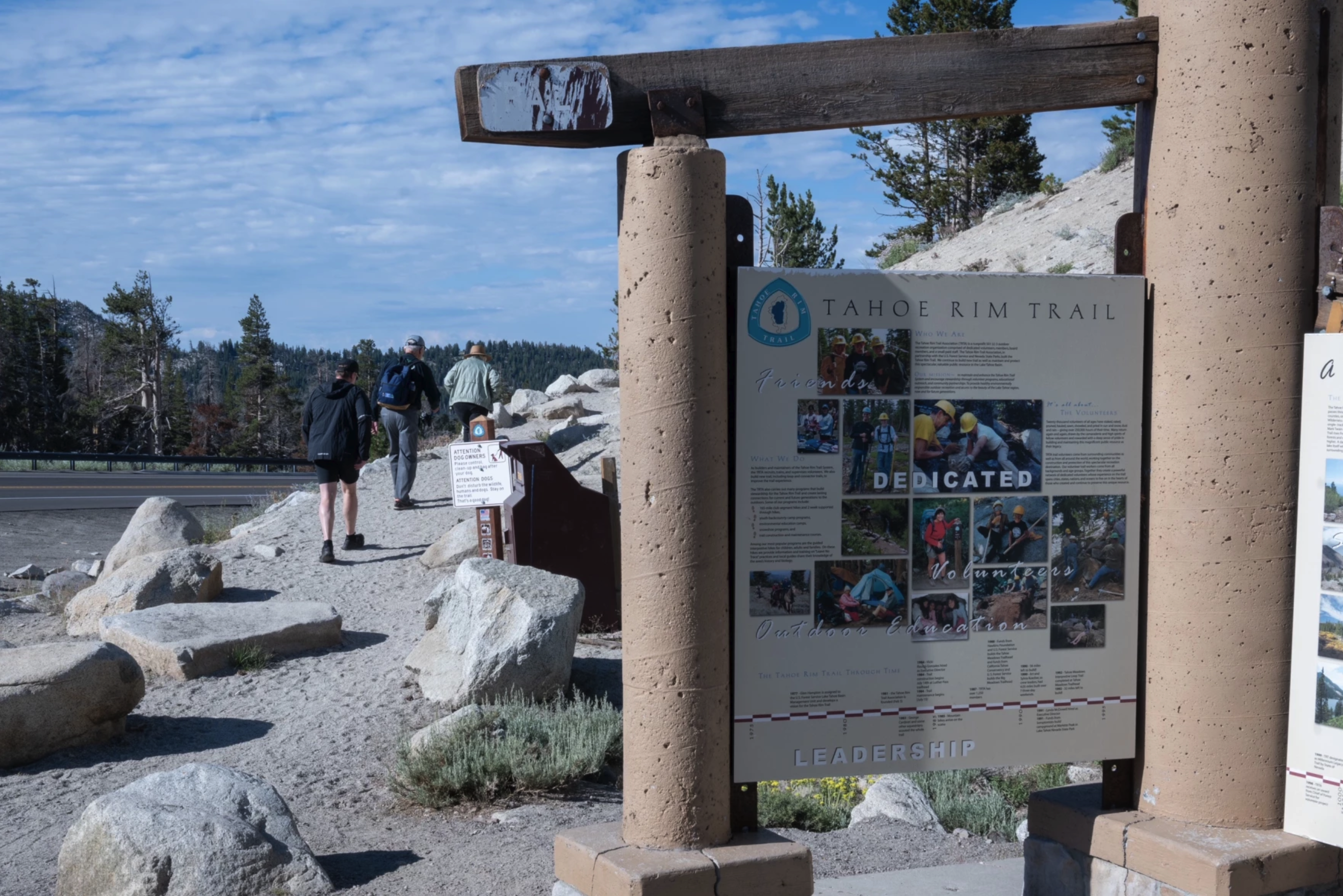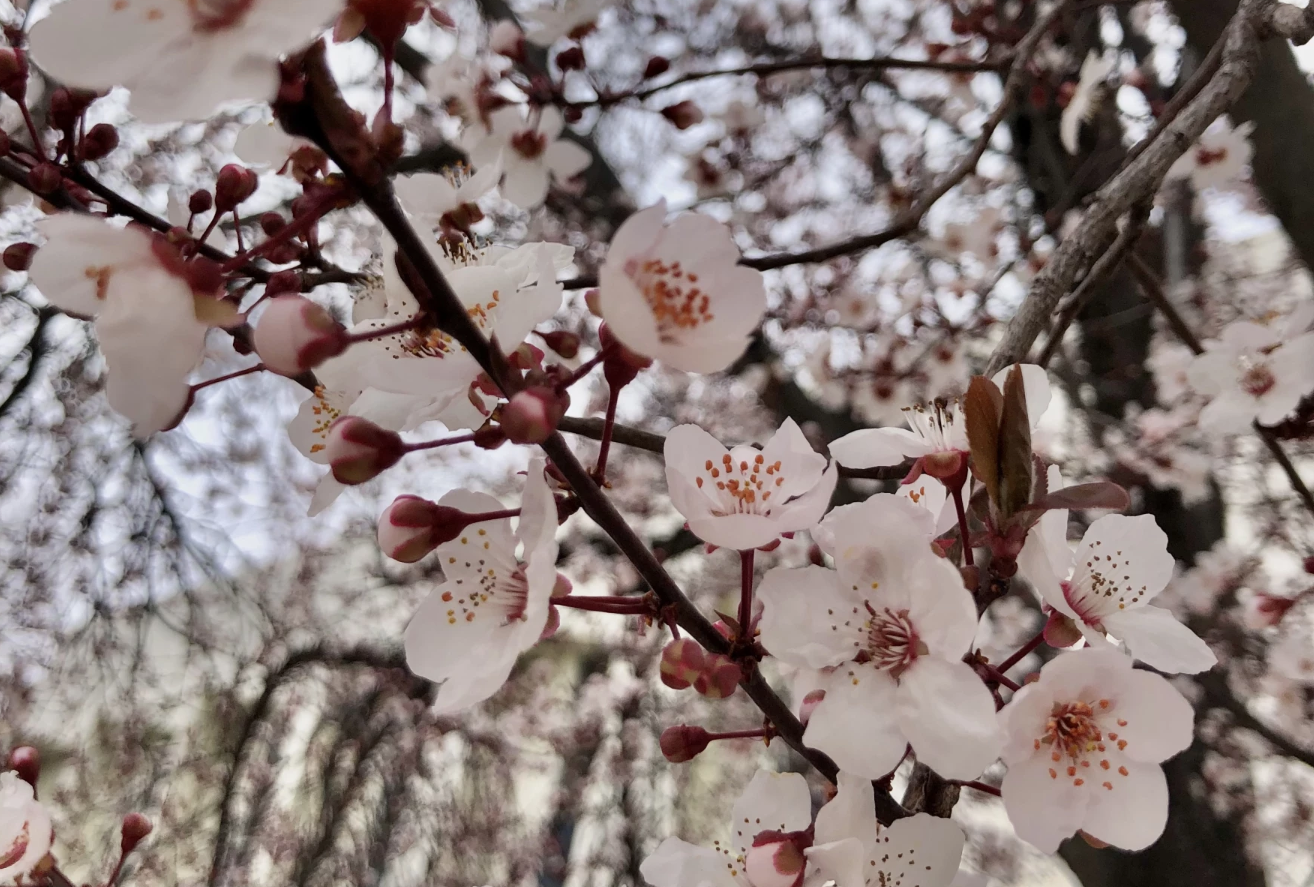Photo: Hikers starting the Tahoe Rim Trail on August 11th, 2023.
This story was produced through a partnership between KUNR and Climate Central, and shared with permission from KUNR Public Radio. For an audio version of the story, please visit the KUNR website.
Nevada saw scorching temperatures during July, a month that set heat records worldwide. But the heat hasn’t stopped people from enjoying the outdoors–in fact, more hikers are using trails than ever before.
Eric Mueller was hiking Mt. Rose trail at around 12:30 in mid-July, stopping to let his dog, a mixed breed named Ethel, sit in a pile of snow that hadn’t melted in the shade. He has lived in the Lake Tahoe area for 6 years, and hikes on trails in Galena during the spring before moving higher up in the mountains when temperatures spike.
While the heat is much more manageable in the mountains, Mueller says he takes extra precautions to ensure Ethel doesn’t get too hot.
“We’ll definitely hike in the trees, and then we’ll stay in the tree level and not go up above with her and with us. It’s still not terrible, but I’m bringing ice water now instead of just regular water, little stuff like that.”
Nevada saw scorching temperatures during July, a month that set heat records worldwide. But the heat hasn’t stopped people from enjoying the outdoors–in fact, more hikers are using Nevada trails than ever before.
In the hottest summer the world has seen in 120,000 years, changes are rippling through Nevada’s robust outdoor sports scene, not by reducing the number of people coming, but by changing when and where they recreate.
The average summer temperature in Reno climbed about 11°F since 1970. But the heat isn’t scaring people off, at least not yet. Nevada’s Division of Outdoor Recreation saw a 34 percent increase in visitation to state parks since the pandemic.

Reno’s average summer temperature has increased by 11.1 degrees since the 1970s. Credit: Climate Central.

Summer temperatures in Nevada have warmed an average of 4 degrees since 1970. Credit: Climate Central.

Reno now experiences approximately 66 more days with temperatures above normal than we did in 1970. Credit: Climate Central
The change in the weather is driving shifts in planning and different approaches to safety, as outdoors people cope with rising temperatures and other impacts of a heating planet.
“When we see extreme temperatures like this, we just try to caution people on what they do when they’re recreating,” says Denise Beronio, administrator of the Nevada Division of Outdoor Recreation, established in 2018 to enhance the $5.5 billion outdoor recreation industry in the state. “We have seen some challenges with people recreating during the heat of the day.”
Failing to take changing weather into account can increase risk of heat-related illness. Heat causes an estimated 700 fatalities and more than 9,000 hospitalizations in the U.S. every year. That’s more than all other natural disasters combined.
“So this is a real important topic to be aware of, and know how to plan for and how to recognize the symptoms and ultimately know when to treat,” says Dr. Grant Lipman, a former professor at Stanford Emergency Medicine and creator of GOES Health, an app designed for people outdoors to help assess the risks ahead.
Dangerous heat increases risk of dehydration and heat stroke, and can affect cardiovascular, respiratory, and nervous systems. Overheating can cause immediate and irreversible damage. Protective proteins begin to break down, allowing blood and fluids to leak and leading to organ failure and shock.
“With heat illness, heat stroke, think of dropping an egg onto a hot pan,” Lipman says. “Your body is that egg and it’s frying on the inside.”
Drinking water is crucial, Lipman says, but so is consuming salt to prevent over-hydrating. Knowing the symptoms of heat-related illness, which often start with confusion or agitation, can also help head off a crisis that can end in multi-organ failure or death.
Planning to spend time in the cooler parts of the day cuts risk. And there’s a silver lining to that approach, says Elisabeth Johnson, deputy administrator for the Nevada Division of Outdoor Recreation. The state has a string of public lands and rural communities with pristine dark skies for viewing the stars without light pollution from cities clouding the view. Hiking at dusk or even after dark can beat the heat, skip the crowds, and allow for enjoying these unique attractions.
“I think sometimes people just think of Vegas and those bright lights and not being able to see the beautiful night sky,” Johnson says. “Nevada is pretty primed for being able to see the stars— once you get out of those kind of major metropolis areas of Vegas and then the Reno area—where you can be just looking up at the sky and see the Milky Way.”
In the future, rising temperatures forecast trouble for iconic pastimes, according to a literature review commissioned by Protect Our Winters, a nonprofit organization of outdoor enthusiasts that campaigns for action to mitigate climate change. While this year’s heavy snowpack created more concerns for too much rather than too little water, and led to crowding on the few dry trails, the long-term trend threatens reservoirs, lakes, and rivers. Dwindling water supplies could be a problem for the estimated 8 million people a year who visit the state to fish, paddleboard, and water ski.
Wildfire can also damage trails, making hiking, trail running or mountain biking more difficult, or even impossible, and transforming the experience for campers who head to pitch tents in the forest and find blackened burn scars instead. And particulate air pollution from wildfire smoke, like the smoke that blew into Nevada from the Bone wildfire northwest of Yosemite National Park in July, is also linked to breathing discomfort and respiratory problems. People may choose to stay indoors to protect their lungs.
“We have seen people starting to make adjustments to their lifestyle and their outdoor recreation activities because of the smoke from fires,” Johnson says. “I had some friends and I noticed that they had bought a stationary bike, and you’re like, ‘What do you need a stationary bike for? We have sunshine 300 days a year,’ and they go, ‘Oh, it’s for smoke season.’”

When snowpack and weather allow, a lot of hikers turn to the higher elevations around the state, including popular destinations around Lake Tahoe like the Tahoe Rim Trail, a 165-mile path hikers, equestrians, and mountain bikers take to loop around the Lake Tahoe Basin on high ridgelines.Hotter, drier weather has prompted hikers planning to complete the trail to call the association to ask about places to stash water in the woods because some natural sources have dried out. Other areas are drowning in runoff as streams are flooded by the winter’s heavy snowpack.
“It’s less of a mediation and more of a feast or famine, so you’re going to get areas that are drowned and areas that are bone dry,” said Anthony Porter, communications director for the Tahoe Rim Trail Association, which supports the Tahoe Rim Trail. “The variation in temperatures and climate has definitely been a challenge.”
Sophia Holm is the 2023 summer intern for KUNR and the Hitchcock Project for Visualizing Science. She covers climate news, issues, and solutions in Reno, Lake Tahoe, and surrounding local areas.






